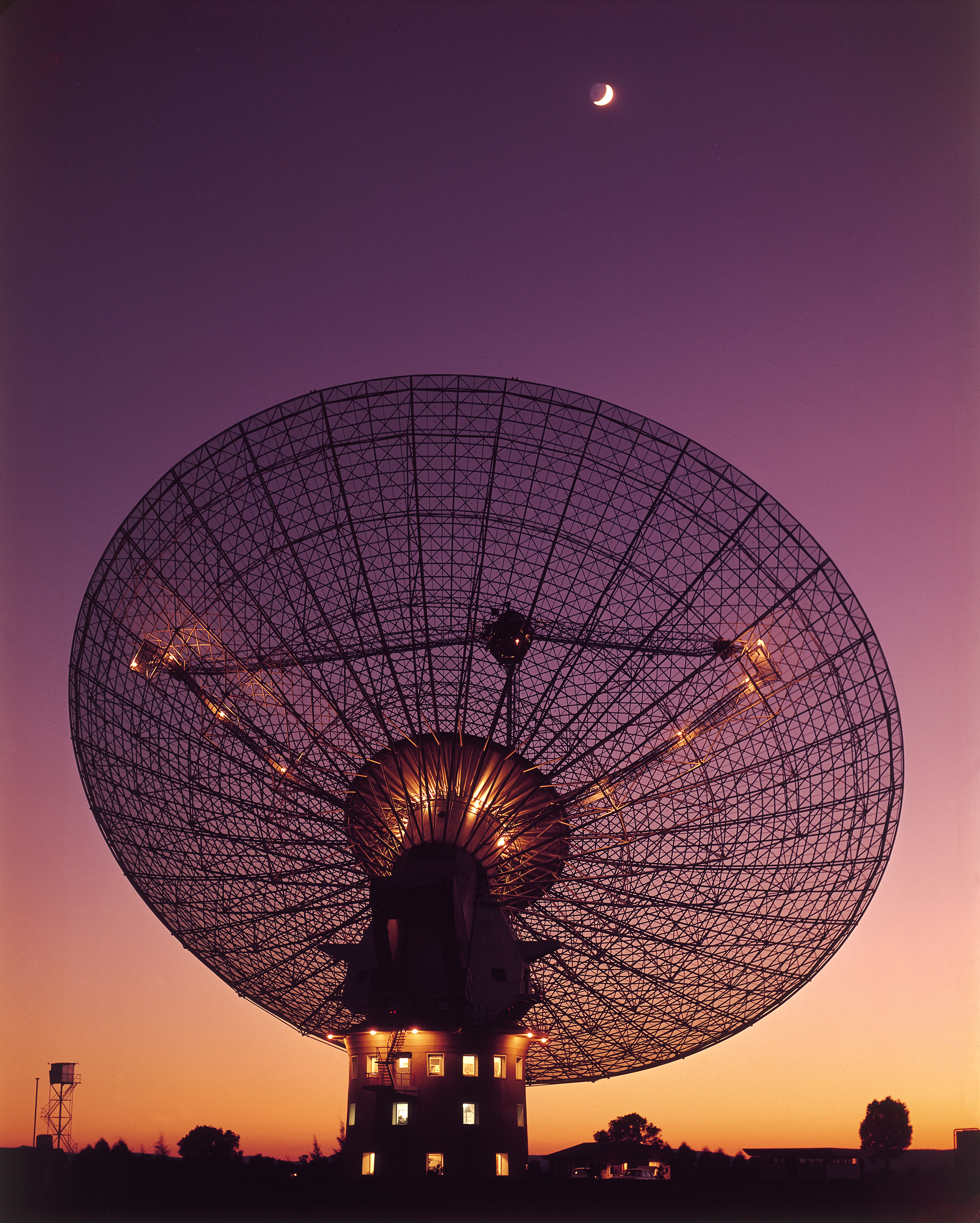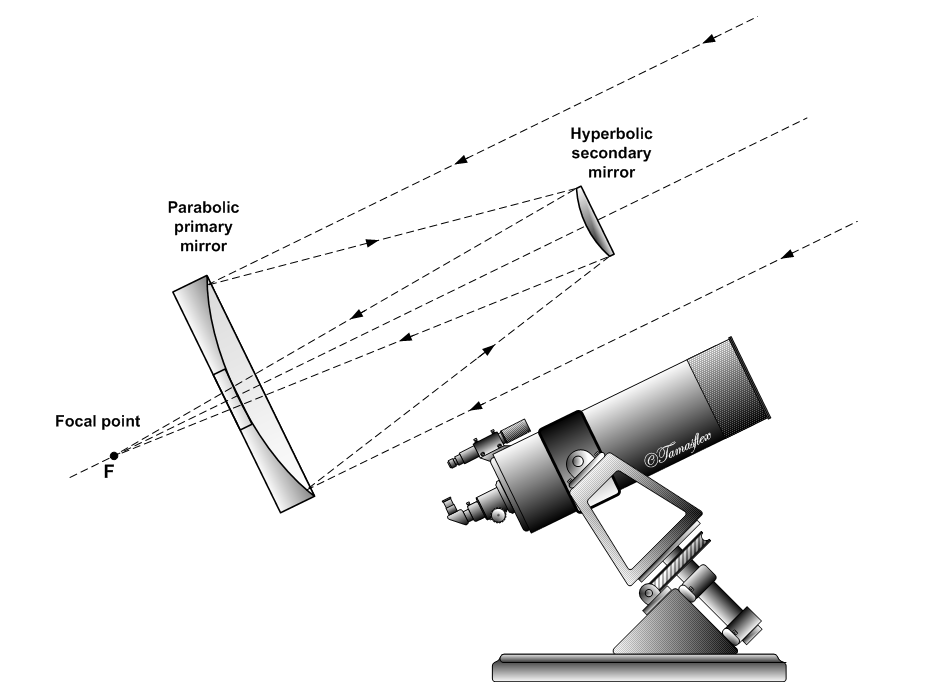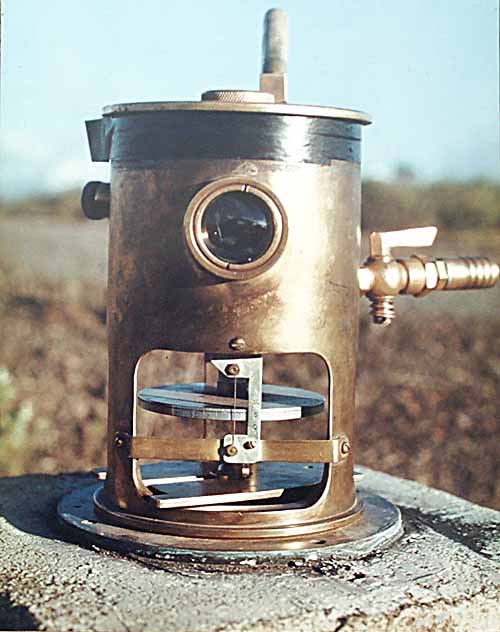|
Leighton Radio Telescopes
The Leighton Radio Telescopes are 10.4 meter parabolic dish antennas designed by Robert B. Leighton in the 1970s, which were fabricated on the Caltech campus during the 1970s and 1980s. The telescope surfaces reached an accuracy of 10 microns RMS, allowing observations throughout the millimeter and submillimeter bands. In all, eight of these telescopes were made. They were used as the six elements of the Owens Valley Radio Observatory (OVRO) millimeter interferometer in California, and as single telescopes at the Caltech Submillimeter Observatory in Hawaii and the Raman Research Institute (RRI) at Bangalore, India. In the spring of 2005, the six Leighton telescopes in Owens Valley were moved to a high mountain site in the White Mountains to form the core of the CARMA array of 25 telescopes. The CARMA array was decommissioned in 2015 at which time the Leighton telescopes were moved back to OVRO, where they are now being repurposed for different projects including the ... [...More Info...] [...Related Items...] OR: [Wikipedia] [Google] [Baidu] |
Radio Telescope
A radio telescope is a specialized antenna and radio receiver used to detect radio waves from astronomical radio sources in the sky. Radio telescopes are the main observing instrument used in radio astronomy, which studies the radio frequency portion of the electromagnetic spectrum emitted by astronomical objects, just as optical telescopes are the main observing instrument used in traditional optical astronomy which studies the light wave portion of the spectrum coming from astronomical objects. Unlike optical telescopes, radio telescopes can be used in the daytime as well as at night. Since astronomical radio sources such as planets, stars, nebulas and galaxies are very far away, the radio waves coming from them are extremely weak, so radio telescopes require very large antennas to collect enough radio energy to study them, and extremely sensitive receiving equipment. Radio telescopes are typically large parabolic ("dish") antennas similar to those employed in trackin ... [...More Info...] [...Related Items...] OR: [Wikipedia] [Google] [Baidu] |
Nasmyth Telescope
The Nasmyth telescope, also called Nasmyth–Cassegrain or Cassegrain–Nasmyth, is a reflecting telescope developed by the Scottish inventor James Nasmyth. It is a modified form of a Cassegrain telescope, with light reflected sideways to an eyepiece. Scheme As in the Cassegrain telescope, the light falls on a concave primary mirror, then is reflected towards a convex secondary mirror. A comparatively small tertiary flat mirror reflects the light to one of the sides of the telescope. (The central hole in the primary mirror may still host a Cassegrain focus if the tertiary can be moved out of the way.) This flat mirror is placed on the altitude axis, so that the beam exits through a hole in the middle of the altitude bearing. This means the eyepiece or instrument does not need to move up and down with the telescope as the tertiary mirror's angle with the main telescope axis is adjustable as a function of the telescope's pointing and the star's elevation above the horizon; therefor ... [...More Info...] [...Related Items...] OR: [Wikipedia] [Google] [Baidu] |
Hale Telescope
The Hale Telescope is a , 3.3 reflecting telescope at the Palomar Observatory in San Diego County, California, US, named after astronomer George Ellery Hale. With funding from the Rockefeller Foundation in 1928, he orchestrated the planning, design, and construction of the observatory, but with the project ending up taking 20 years he did not live to see its commissioning. The Hale was groundbreaking for its time, with double the diameter of the second-largest telescope, and pioneered many new technologies in telescope mount design and in the design and fabrication of its large aluminum coated "honeycomb" low thermal expansion Pyrex mirror. It was completed in 1949 and is still in active use. The Hale Telescope represented the technological limit in building large optical telescopes for over 30 years. It was the largest telescope in the world from its construction in 1949 until the Soviet BTA-6 was built in 1976, and the second largest until the construction of the Keck Ob ... [...More Info...] [...Related Items...] OR: [Wikipedia] [Google] [Baidu] |
Space Frame
In architecture and structural engineering, a space frame or space structure ( 3D truss) is a rigid, lightweight, truss-like structure constructed from interlocking struts in a geometric pattern. Space frames can be used to span large areas with few interior supports. Like the truss, a space frame is strong because of the inherent rigidity of the triangle; flexing loads (bending moments) are transmitted as tension and compression loads along the length of each strut. History Alexander Graham Bell from 1898 to 1908 developed space frames based on tetrahedral geometry. Bell's interest was primarily in using them to make rigid frames for nautical and aeronautical engineering, with the tetrahedral truss being one of his inventions. Max Mengeringhausen developed the space grid system called MERO (acronym of ''MEngeringhausen ROhrbauweise'') in 1943 in Germany, thus initiating the use of space trusses in architecture. The commonly used method, still in use has individual tubula ... [...More Info...] [...Related Items...] OR: [Wikipedia] [Google] [Baidu] |
Cassegrain Reflector
The Cassegrain reflector is a combination of a primary concave mirror and a secondary convex mirror, often used in optical telescopes and radio antennas, the main characteristic being that the optical path folds back onto itself, relative to the optical system's primary mirror entrance aperture. This design puts the focal point at a convenient location behind the primary mirror and the convex secondary adds a telephoto effect creating a much longer focal length in a mechanically short system. In a symmetrical Cassegrain both mirrors are aligned about the optical axis, and the primary mirror usually contains a hole in the center, thus permitting the light to reach an eyepiece, a camera, or an image sensor. Alternatively, as in many radio telescopes, the final focus may be in front of the primary. In an asymmetrical Cassegrain, the mirror(s) may be tilted to avoid obscuration of the primary or to avoid the need for a hole in the primary mirror (or both). The classic Cassegrai ... [...More Info...] [...Related Items...] OR: [Wikipedia] [Google] [Baidu] |
F-number
In optics, the f-number of an optical system such as a camera lens is the ratio of the system's focal length to the diameter of the entrance pupil ("clear aperture").Smith, Warren ''Modern Optical Engineering'', 4th Ed., 2007 McGraw-Hill Professional, p. 183. It is also known as the focal ratio, f-ratio, or f-stop, and is very important in photography. It is a dimensionless number that is a quantitative measure of lens speed; increasing the f-number is referred to as ''stopping down''. The f-number is commonly indicated using a lower-case hooked f with the format ''N'', where ''N'' is the f-number. The f-number is the reciprocal of the relative aperture (the aperture diameter divided by focal length). Notation The f-number is given by: N = \frac \ where f is the focal length, and D is the diameter of the entrance pupil (''effective aperture''). It is customary to write f-numbers preceded by "", which forms a mathematical expression of the entrance pupil diamet ... [...More Info...] [...Related Items...] OR: [Wikipedia] [Google] [Baidu] |
Tiltmeter
A tiltmeter is a sensitive inclinometer designed to measure very small changes from the vertical level, either on the ground or in structures. Tiltmeters are used extensively for monitoring volcanoes, the response of dams to filling, the small movements of potential landslides, the orientation and volume of hydraulic fractures, and the response of structures to various influences such as loading and foundation settlement. Tiltmeters may be purely mechanical or incorporate vibrating-wire or electrolytic sensors for electronic measurement. A sensitive instrument can detect changes of as little as one arc second. Tiltmeters have a long history, somewhat parallel to the history of the seismometer. The very first tiltmeter was a long-length stationary pendulum. These were used in the very first large concrete dams, and are still in use today, augmented with newer technology such as laser reflectors. Although they had been used for other applications such as volcano monitoring, th ... [...More Info...] [...Related Items...] OR: [Wikipedia] [Google] [Baidu] |
Intermediate Frequency
In communications and electronic engineering, an intermediate frequency (IF) is a frequency to which a carrier wave is shifted as an intermediate step in transmission or reception. The intermediate frequency is created by mixing the carrier signal with a local oscillator signal in a process called heterodyning, resulting in a signal at the difference or beat frequency. Intermediate frequencies are used in superheterodyne radio receivers, in which an incoming signal is shifted to an IF for amplification before final detection is done. Conversion to an intermediate frequency is useful for several reasons. When several stages of filters are used, they can all be set to a fixed frequency, which makes them easier to build and to tune. Lower frequency transistors generally have higher gains so fewer stages are required. It's easier to make sharply selective filters at lower fixed frequencies. There may be several such stages of intermediate frequency in a superheterodyne receiver ... [...More Info...] [...Related Items...] OR: [Wikipedia] [Google] [Baidu] |





